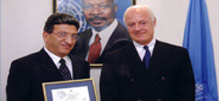September 2013
As hundreds of tons of radioactive water were leaking from the wrecked Japanese Fukushima Daiichi nuclear power plant hit by the tsunami in 2011, thousands of people were being killed by chemical weapons on the outskirts of Damascus. Killing by radioactive material is similar to killing by chemical agents in that both are silent, whereby death sneaks without wounds and blood. But the extent of this similarity does not go beyond silent death. For whereas the causes of the Fukushima disaster and its ongoing effects were the elements of nature combined with human error, those who annihilated human beings by chemical weapons, whoever they may be, committed their crime willfully and deliberately. However, the victims in both cases were human beings and the natural environment.
Two years through the Fukushima nuclear disaster, authorities and the nuclear industry propagated that the situation was under control and that complications have been contained; it turned out that such claims were not true. Thousands of tons of water were used, during the past two years, to cool the crippled nuclear reactors. Around one thousand tanks were built for storing the highly radioactive water. It was disclosed, last month, that hundreds of tons of irradiated water had seeped from storage tanks to the ocean and the groundwater. What is worse is that cooling the reactors still requires a daily amount of 400 tons of water that will turn into highly contaminated wastewater which needs to be stored. The existing tanks have been used up to 85 percent of their capacity, not to mention that they have cracks that led to the leaks. Moreover, experts are concerned about severe ruptures of the tanks and leakage of their radioactive content in the event of another earthquake or tsunami, even if lesser in magnitude than the ones of 2011.
The Fukushima contaminated water is so highly radioactive that a person standing half a meter away would, within an hour, receive a radiation dose five times the average of workers operating in nuclear plants are exposed to in one year. After ten hours, a person standing in that proximity to the leak would develop radiation sickness with symptoms including nausea and a drop in white blood cells. It is true that the risks of accidents are associated with human activities in general, including power generation from oil, gas, coal, hydro, wind or solar energy. But the effects of such incidents are limited in scope, time and space, and end with the victims being killed or injured.A nuclear incident, on the other hand, does not come to a foreseen closure. Radioactivity persists thousands of years and is transmitted through air, soil and water across unpredictably limitless realms. Chemical contamination is somewhat similar to nuclear pollution in the extent of its dispersal and long-term impacts, though it is not as limitless as nuclear contamination.
Undoubtedly, nuclear power generation remains a choice to be considered among possible ways to diversify energy sources. But the continued Fukushima aftermath calls for more scrutiny. The cost of nuclear power generation is not limited to building and operating reactors, but also involves the treatment of radioactive nuclear waste and effects of nuclear accidents. Radioactive waste storage remains the main challenge facing nuclear industry, as was recently manifested in the USA which was the first country to generate electricity from nuclear power, in 1951. After decades of research and investments exceeding ten billion dollars, the Obama administration had to suspend a project to build a permanent nuclear waste storage facility in Yucca Mountain, due to technological and natural constraints. Until reaching an appropriate solution for the permanent storage of radioactive waste, the US government spending billions of dollars annually on temporary storage, which amounts to outright subsidies to the nuclear industries.
One main rationale of nuclear power advocates is that it contributes to the mitigation of CO2 emissions, a true argument which cannot be refuted. But a feasibility study should draw comparison between the cost of damage from CO2 emissions due to burning fossil fuels, and the cost of radioactive waste storage in addition to the cost of nuclear disasters. Otherwise, any calculation would be superficial and incomprehensive.
In considering real gains and losses, states aspiring to join the so-called "nuclear renaissance" should take a warning from the persistent Fukushima disaster.
|




